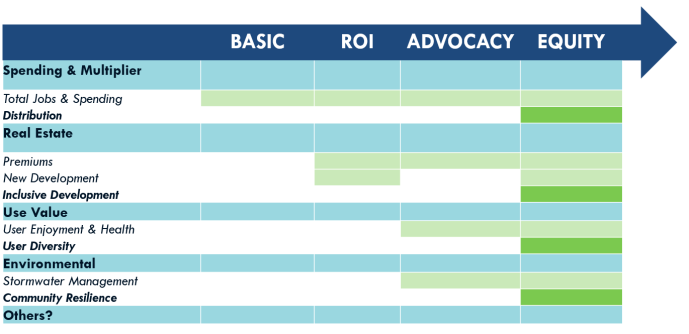on Jun 01, 2017
Measuring Park Equity
By: Elissa Hoagland Izmailyan
As established American cities emerged from the disinvestment of the mid-twentieth century, they used parks as a tool to attract people and investment back to the urban core. HR&A’s work in cities supported the economic case for parks and other investments that have transformed the urban landscape. Now, with the economic value of parks being widely accepted, many cities are seeking a transformative “High Line” of their own, but how can we make sure these investments are enjoyed by everyone?
There’s opportunity to shape the next generation of park investment around a set of shared principles for equitable urban development by ensuring public spaces are embraced by communities of all means and backgrounds. To do so, park organizations are looking to influence park-oriented development, create inclusive communities and protect current residents. To support these efforts, HR&A is looking beyond the economic value that parks create to evaluate their social and community value and how that value can be equitably shared.
Measuring Equity
We measure what we care about. As a result, yesterday’s economic impact analyses were often conducted in order to secure funding tied to specific project benefits (e.g., Tax Increment Financing districts tied to real estate value). As our values change, so too must our measurements. Our new measurements must consider the success of parks as engines of inclusion in addition to economic vitality. This includes:
- Distribution of economic benefits amongst constituencies and communities
- Neighborhood-scale impacts including resident composition, local business impacts, and quality of life
- Community resilience in addition to well-established ecological benefits
The Social and Economic Report Card
This revised economic and social “report card” underpins an equitable planning approach that extends beyond the immediate recreational or aesthetic mission of parks:
- Project design and programming that reflect the interests, needs, and access of diverse constituencies as a means to creating an inclusive gathering space.
- Neighborhood planning and policy that looks past the boundaries of the park itself to ensure that each project connects physically, programmatically, and aesthetically with its community. With a careful eye to existing neighborhood conditions and aspirations, we can use park design and the tools of planning, zoning, housing policy, neighborhood investment, and participatory development to ensure that the community benefits from park investment, has access to adequate and diverse housing, and is resilient to socioeconomic change.
- Organizational implementation to ensure that the leadership and staff composition of parks organizations reflect their constituents, and that community relations are inclusive, transparent, and effective.
- A new funding model that reflects these needs and opportunities. Equitable park investment is likely to require a more nuanced funding strategy than that of downtown gems over the past two decades. Opportunities for earned income and real estate value capture may be more modest by design for next generation park investments, even as an increased focus on neighborhood investment increases costs. Direct participation in neighborhood development can open up new revenue sources, as can collaboration with community development organizations and funders.
Elissa Hoagland Izmailyan is the former Managing Principal of HR&A’s Dallas office. If you’d like to know more about HR&A’s Parks and Open Space practice, please reach out to HR&A Vice Chairman, Candace Damon.
